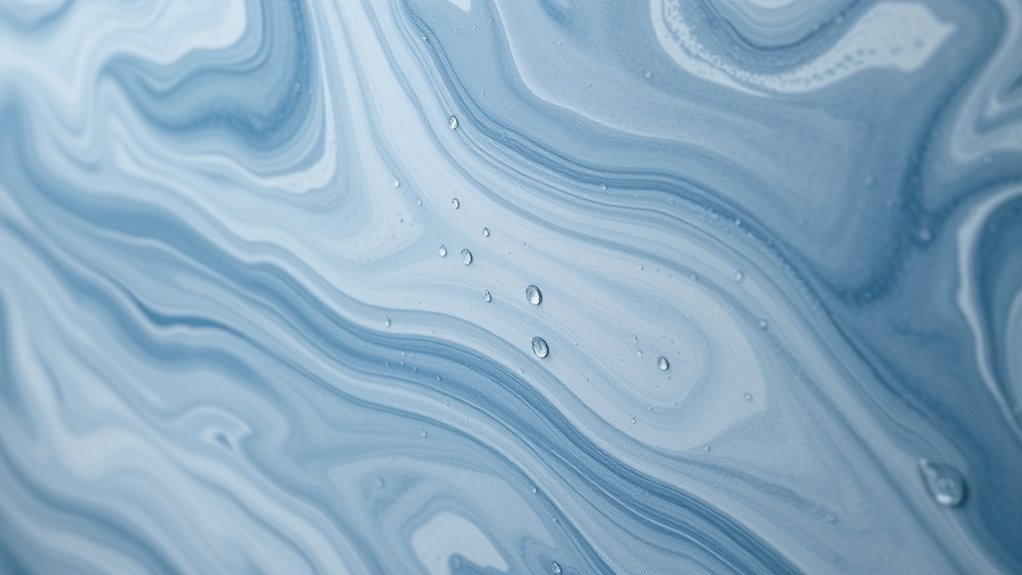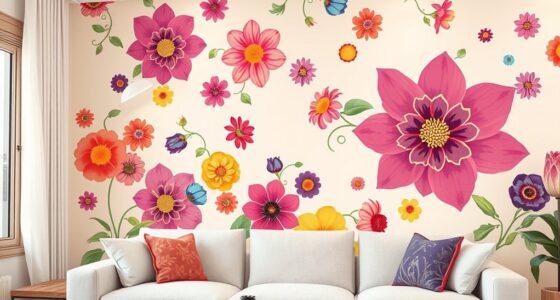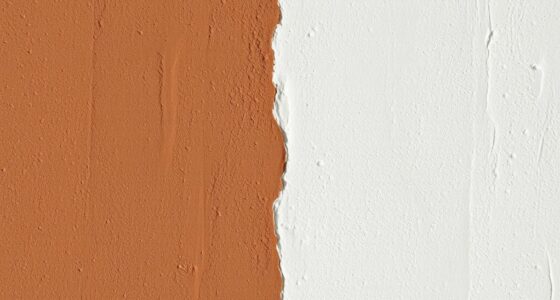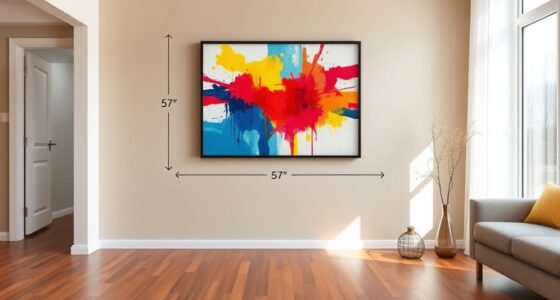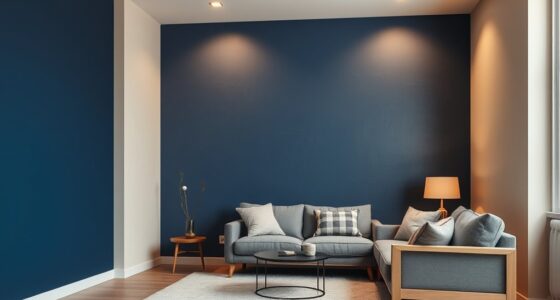When choosing wallpaper for your bathroom, opt for moisture-resistant options like vinyl or coated papers that withstand humidity without peeling or mold growth. Be sure to prepare your walls by cleaning, repairing, and applying waterproof primers or sealants before installation. Use high-quality, mold-resistant adhesives and proper installation techniques to prevent moisture damage. Regular maintenance, like wiping surfaces and ensuring good ventilation, will prolong your wallpaper’s life. Keep exploring for detailed tips to ensure your bathroom stays stylish and protected.
Key Takeaways
- Choose moisture-resistant wallpaper like vinyl or coated paper designed for high-humidity environments.
- Use waterproof adhesives and apply waterproof coatings or sealants for added moisture protection.
- Properly prepare walls by cleaning, repairing, and ensuring they are dry before wallpaper installation.
- Apply a moisture barrier and avoid over-saturating wallpaper or seams during installation.
- Maintain the wallpaper by regular cleaning, repairing damage promptly, and ensuring good bathroom ventilation.
Types of Bathroom Wallpaper Suitable for Humid Environments

Are you wondering which bathroom wallpapers stand up best to humidity and moisture? You’ll want to look for options designed for damp environments, like those with moisture resistant adhesives. These adhesives help the wallpaper stay securely attached despite high humidity levels. When choosing decorative wallpaper options, opt for materials specifically made to resist moisture, such as vinyl or coated papers. These types are less likely to peel, warp, or develop mold, ensuring your bathroom looks fresh longer. You might also consider wallpapers with waterproof coatings or textured vinyl finishes—they’re durable and easy to clean. Avoid traditional paper wallpapers, which tend to absorb moisture and deteriorate quickly. Selecting the right moisture-resistant adhesives and durable decorative options is key to maintaining a beautiful, lasting bathroom wall. Understanding moisture-resistant materials can help you make more informed choices for bathroom decor. Proper installation techniques and moisture management are also essential to prolong the lifespan of bathroom wallpaper. Incorporating moisture barriers during installation can further protect your walls from excessive humidity and prevent damage over time. Additionally, choosing wallpapers with breathable surfaces can help reduce trapped moisture and improve ventilation.
Selecting the Right Material for Moisture Resistance
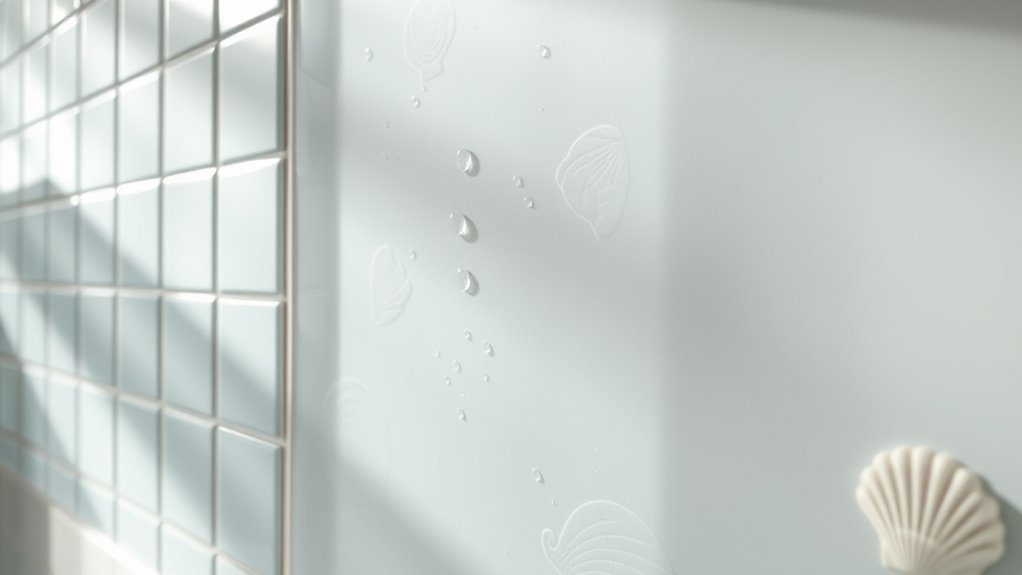
Choosing the right material for moisture resistance is essential to guarantee your bathroom wallpaper withstands humidity and prevents damage. Start by selecting wallpaper designed specifically for high-moisture areas, such as vinyl or fibreglass-backed options. These materials are naturally more resistant to water and humidity. To make certain secure adhesion, use moisture resistant adhesives formulated for damp environments; these help prevent peeling and bubbling over time. Additionally, apply decorative waterproof coatings over the wallpaper for extra protection against moisture infiltration. These coatings act as a barrier, sealing the wallpaper and enhancing its durability. Incorporating water-resistant materials into your wall coverings further ensures long-term durability and reduces the risk of mold or mildew growth. For optimal results, consider moisture barriers that can be installed behind the wallpaper for added protection. Utilizing moisture-resistant adhesives can also improve the longevity of your wallpaper in humid conditions. As an added measure, selecting moisture-resistant paints for finishing can provide an extra layer of defense against humidity. By combining suitable materials with proper adhesives and waterproof finishes, you create a resilient wall covering that endures humidity and maintains its appearance long-term.
Preparing Your Bathroom Walls for Wallpaper Application

Before applying wallpaper in your bathroom, you need to make sure the walls are properly prepared to achieve a smooth and long-lasting finish. Start by cleaning the walls thoroughly to remove dirt, grease, and soap residue. Smooth out any bumps or holes with spackle, then sand the surface lightly for better adhesion. Choose wallpaper patterns that complement your bathroom lighting to enhance the space’s ambiance. Proper preparation also involves making certain the wall is dry and free of moisture, especially in humid areas. Here’s a quick guide:
| Step | Action | Tips |
|---|---|---|
| Clean | Wash walls with mild soap | Remove soap scum and grime |
| Repair | Fill holes and cracks | Use moisture-resistant spackle |
| Sand | Lightly sand surface | Create a smooth base |
| Dry | Making sure walls are dry | Prevent moisture issues |
A crucial aspect to consider is the humidity resistance of the wallpaper to ensure it withstands the bathroom environment over time.
Proper Installation Techniques to Prevent Moisture Damage
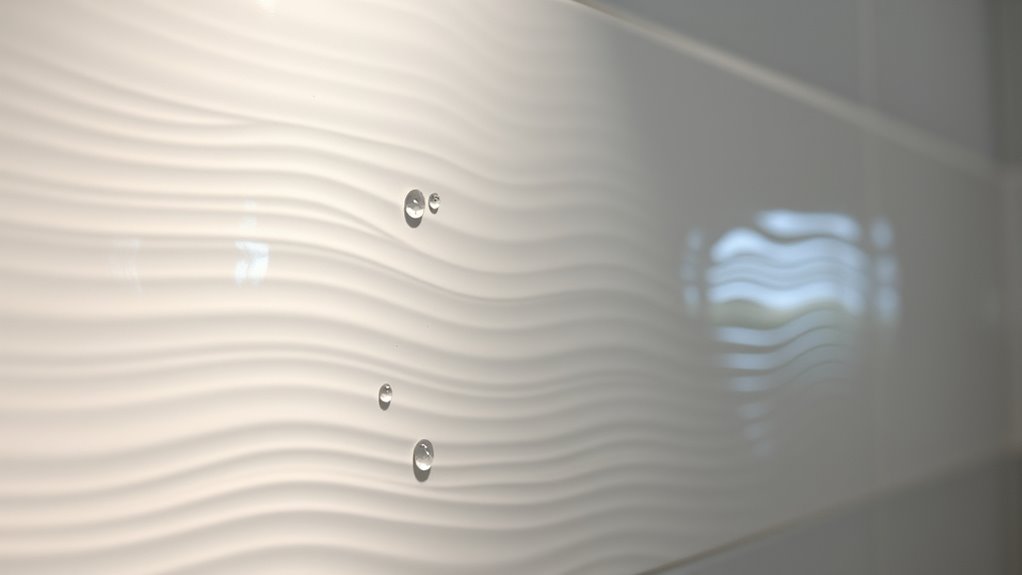
Proper installation is essential to prevent moisture damage in your bathroom wallpaper. Start by applying a reliable moisture barrier, like a waterproof primer or sealant, to protect the wall surface. This step creates a moisture-resistant layer that reduces the risk of water infiltration. When choosing adhesive, opt for a high-quality, mold-resistant variety designed for humid environments. Make sure to apply the adhesive evenly and follow the manufacturer’s instructions carefully to guarantee a secure bond. Press the wallpaper firmly onto the wall, smoothing out any air bubbles or wrinkles. Avoid over-saturating the wallpaper or adhesive, as excess moisture can seep into seams and cause damage over time. Proper installation techniques are crucial for ensuring your wallpaper can withstand bathroom humidity and stay looking fresh longer. Additionally, selecting appropriate wallpaper materials designed for humid conditions can significantly extend its lifespan.
Maintenance and Long-term Care for Bathroom Wallpaper
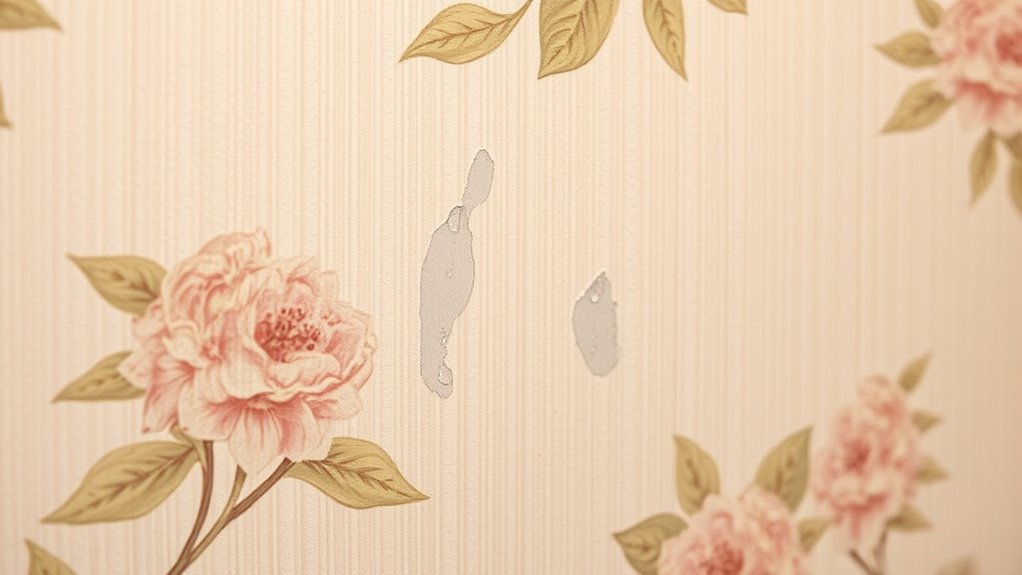
To keep your bathroom wallpaper looking its best over time, regular maintenance is essential. Start by gently wiping the surface with a soft, damp cloth to remove dust and moisture buildup, especially on artistic patterns that can trap grime. Check for any peeling edges or bubbling, and address them promptly with appropriate adhesive touch-ups. To preserve its vibrant color coordination, avoid harsh cleaners that can fade or damage the wallpaper. Consider applying a clear, waterproof sealant periodically to protect against humidity. Keep ventilation active to reduce moisture exposure, which helps prevent mold and peeling. Proper care not only maintains the visual appeal of your artistic patterns but also extends the wallpaper’s lifespan, ensuring your bathroom remains stylish and inviting for years to come. Regularly inspecting your humidity levels can help you take proactive steps to prevent damage. Additionally, understanding humidity considerations is crucial for choosing the right protective treatments and maintaining the integrity of your wallpaper over time. Being aware of humidity effects helps in selecting appropriate materials and treatments that resist moisture damage. Using an air purifier designed to reduce airborne pollutants can also contribute to a healthier bathroom environment and help control excess humidity levels.
Frequently Asked Questions
How Often Should Bathroom Wallpaper Be Replaced Due to Humidity?
You should replace bathroom wallpaper every 3 to 5 years, depending on humidity levels and maintenance. High moisture can shorten its lifespan, causing peeling or mold. To extend its life, regularly ventilate your bathroom, wipe down walls, and use moisture-resistant wallpaper or sealants. Proper maintenance tips help prevent damage, so check for signs of wear frequently and consider replacing it sooner if you notice peeling or mold growth.
Can Wallpaper Prevent Mold Growth in High-Moisture Areas?
Can wallpaper truly prevent mold growth in high-moisture areas? It can, if you choose moisture-resistant wallpapers coated with mold-resistant treatments. These special wallpapers act as a barrier, slowing moisture buildup that fosters mold. But beware—regular maintenance and proper ventilation are essential. Without them, even the best wallpaper might not stop mold entirely. You hold the power to protect your bathroom, but only if you select the right materials.
Are There Eco-Friendly Wallpaper Options Suitable for Bathrooms?
Yes, you can find eco-friendly wallpaper options suitable for bathrooms. Look for sustainable wallpaper materials like recycled paper or plant-based fibers, which resist moisture better. Use eco-friendly adhesives that are low in VOCs to minimize environmental impact. These options help you create a stylish, sustainable bathroom space while ensuring durability against humidity. Choosing these environmentally conscious materials and adhesives makes your bathroom both eco-friendly and functional.
How Does Ventilation Impact Wallpaper Durability in Bathrooms?
Good ventilation systems are essential for maintaining wallpaper durability in your bathroom. They help with moisture control by reducing humidity levels, which prevents wallpaper from peeling or mold growth. When you guarantee proper airflow, your wallpaper stays intact longer, maintaining its appearance. You should regularly use exhaust fans or open windows during and after showers to keep moisture levels low, protecting your wallpaper from damage caused by excess humidity.
What Are Signs of Wallpaper Damage Caused by Humidity?
You’ll notice signs of wallpaper damage caused by humidity, like peeling edges and bubbling patches, as the moisture weakens the adhesive. Over time, high humidity makes the wallpaper lose its grip, causing sections to lift or bubble. You might also see mold or discoloration in affected areas. If these signs appear, it’s a good idea to improve ventilation and consider resealing or replacing the wallpaper to prevent further damage.
Conclusion
Choosing the right wallpaper for your bathroom is like giving your walls a waterproof suit—they’ll stand up to humidity and steam. With proper prep, quality materials, and careful installation, your bathroom can become a stylish oasis that’s built to last. Regular maintenance keeps it looking fresh and vibrant, so your wallpaper remains a steadfast friend through every splash and spill. Embrace these tips, and your bathroom will stay beautiful, weathering every storm like a resilient ship on calm seas.
